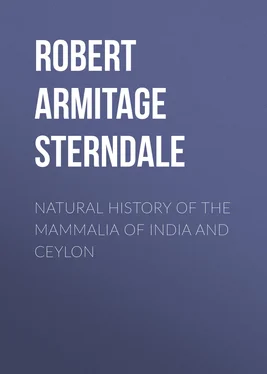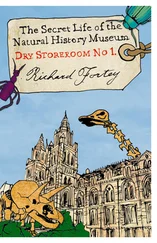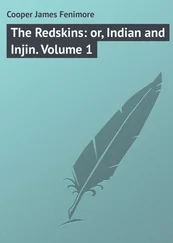Robert Armitage Sterndale - Natural History of the Mammalia of India and Ceylon
Здесь есть возможность читать онлайн «Robert Armitage Sterndale - Natural History of the Mammalia of India and Ceylon» — ознакомительный отрывок электронной книги совершенно бесплатно, а после прочтения отрывка купить полную версию. В некоторых случаях можно слушать аудио, скачать через торрент в формате fb2 и присутствует краткое содержание. Жанр: foreign_edu, Биология, на английском языке. Описание произведения, (предисловие) а так же отзывы посетителей доступны на портале библиотеки ЛибКат.
- Название:Natural History of the Mammalia of India and Ceylon
- Автор:
- Жанр:
- Год:неизвестен
- ISBN:нет данных
- Рейтинг книги:5 / 5. Голосов: 1
-
Избранное:Добавить в избранное
- Отзывы:
-
Ваша оценка:
- 100
- 1
- 2
- 3
- 4
- 5
Natural History of the Mammalia of India and Ceylon: краткое содержание, описание и аннотация
Предлагаем к чтению аннотацию, описание, краткое содержание или предисловие (зависит от того, что написал сам автор книги «Natural History of the Mammalia of India and Ceylon»). Если вы не нашли необходимую информацию о книге — напишите в комментариях, мы постараемся отыскать её.
Natural History of the Mammalia of India and Ceylon — читать онлайн ознакомительный отрывок
Ниже представлен текст книги, разбитый по страницам. Система сохранения места последней прочитанной страницы, позволяет с удобством читать онлайн бесплатно книгу «Natural History of the Mammalia of India and Ceylon», без необходимости каждый раз заново искать на чём Вы остановились. Поставьте закладку, и сможете в любой момент перейти на страницу, на которой закончили чтение.
Интервал:
Закладка:
HABITAT.—Nepal.
DESCRIPTION.—Differs from the last "by a stouter make, by ears smaller and legs entirely nude, and by a longer and more tetragonal tail; colour sooty black, with a vague reddish smear; the nude parts fleshy grey; snout to rump, 3-5/8 inches; tail, 2 inches, planta, 11/16 inch. Found only in woods and coppices."— Hodgson .
HABITAT.—Southern India, Burmah and Ceylon.
DESCRIPTION.—Colour dusky greyish, with rufous brown tips to the hairs ( Blyth ). Above dusky slate colour with rufescent tips to the fur; beneath paler, with a faint rufous tinge about the breast ( Jerdon ). Fur short ashy-brown, with a ferruginous smear on the upper surface; beneath a little paler coloured ( Kellaart ). Teeth and limbs small; tail slender.
SIZE.—Head and body about 4½ inches; tail, 2 inches; skull, 1-2/10 inch.
The smell of this musk shrew is said by Kellaart, who names it S. Kandianus , to be quite as powerful as that of S. cærulescens . Blyth seems to think that this animal gets more rufescent with age, judging from two examples sent from Mergui. By some oversight, I suppose, he has not included this species in his 'Catalogue of the Mammals of Burmah.'
HABITAT.—Darjeeling.
DESCRIPTION.—"Colour uniform deep brown, inclining to blackish, with a very slight rufescent shade; fur short, with an admixture of a few lengthened piles, when adpressed to the body smooth, but reversed somewhat harsh and rough; tail cylindrical, long, gradually tapering; mouth elongated, regularly attenuated, ears moderate, rounded."
SIZE.—Head and body, 5½ inches; tail, 3 inches.
Jerdon seems to think this is the same as S. Griffithi or closely allied; I cannot say anything about this, as I have no personal knowledge of the species, but on comparison with the description of S. Griffithi (which see further on) I should say they were identical.
HABITAT.—Dehra Doon.
DESCRIPTION.—"Light rufescent sandy brown, paler beneath; unusually well clad even on the feet and tail, this last being covered with shortish fur having numerous long hairs intermixed; form very robust; basal portion of tail very thick."
SIZE.—Head and body, 4½ inches; tail, 2¾ inches; hind foot, 7/8 inch.
HABITAT.—Ootacamund, Neilgherry hills.
DESCRIPTION.—"Blackish-brown, with a rufescent shade on the upper parts; abdomen greyish; tail equal in length to the entire animal, exclusive of the head, gradually tapering to a point; snout greatly attenuated. Length of head and body, 3½ inches; of the tail, 2½ inches."— Horsfield .
HABITAT.—Nepal.
DESCRIPTION.—Uniform blackish-brown colour; tail very long and slender, exceeding in length the head and body, terminating in a whitish tip of half an inch long.
SIZE.—Head and body, 3 inches; tail, 2½ inches. Jerdon supposes that it is found at great altitudes, from Hodgson having in another place described it (MSS.) under the name nivicola .
HABITAT.—Nepal, Sikim, Mussoorie.
DESCRIPTION.—According to Hodgson, nearly the size of S. nemorivagus , "but distinguished by its feet being clad with fur down to the nails, and by its depressed head and tumid bulging cheeks (mystaceal region); ears large and exposed; colour a uniform sordid or brownish-slaty blue, extending to the clad extremities; snout to rump, 3½ inches; tail, 2½ inches; planta, 13/16 inch. This animal was caught in a wood plentifully watered, but not near the water. It had no musky smell when brought to me dead."
HABITAT.—Ceylon, mountainous parts.
DESCRIPTION.—"Fur above sooty black without any ferruginous smear, beneath lighter coloured; whiskers long, silvery grey; some parts of legs and feet greyish, clothed with adpressed hairs; claws short, whitish; ears large, round, naked; outer margin lying on a level with the fur of the head and neck, the ears being thus concealed posteriorly; tail tetragonal, tapering, shorter than head and body."— Kellaart .
SIZE.—Head and body, 3¾ inches; tail, 2¼ inches; hind feet, 1/3 inch.
HABITAT.—Ceylon, Dimboola, below Newara Elia.
DESCRIPTION.—"Colour uniform dusky or dusky slate, with the tips of the fur rufescent; fur long; large sebaceous anal glands; smell very powerful."— Kellaart .
SIZE.—Head and body, 3¾ inches; tail, 2¼ inches.
HABITAT.—Khasia hills and Arracan.
DESCRIPTION.—"Deep blackish-brown, with a slight rufous reflection in a certain light; fur short, close, soft, and adpressed; tail thick at the base, with a few long very slender straggling hairs along its entire length; ears small and rounded; snout elongated."— Horsfield .
SIZE.—Head and body, 5¾ inches; tail, 2½ inches.
Horsfield puts this down as having been found in Afghanistan by Griffiths, but this is an error owing to Griffiths' Afghanistan and Khasia collections having got mixed up.
HABITAT.—Khasia hills.
DESCRIPTION.—"Very similar to S. soccatus in general appearance, but less dark coloured, with shorter fur, and pale instead of blackish feet and tail underneath; the feet too are broader, especially the hind feet, and they have a hairy patch below the heel" ( Blyth ). The skull is narrower, and the upper incisors less strongly hooked.
Teeth small; upper incisors shorter and less strongly hooked than in restricted Sorex ; posterior spur large; lower incisors serrated with three coronal points. Feet very large.
HABITAT.—Ceylon.
DESCRIPTION.—Fur, long, soft uniform blackish—faint rufescent tinge.
SIZE.—Head and body 4¼ inches; tail 2¼.
The following species are of a more diminutive type, and are commonly called "pigmy-shrews;" in other respects they are true shrews.
HABITAT.—Nepal and Sikim.
DESCRIPTION.—Brown, with a slight tinge of chestnut; feet and tail furred; claws white.
SIZE.—Head and body 1½ inch; tail, 1 inch.
Found in coppices and fields; rarely entering houses.
HABITAT.—Neilgherry hills, probably also other parts of Southern India.
DESCRIPTION.—"Back deep blackish-brown; belly pale; limbs and feet brown; palms and plantæ clad with hairs; ears large, conspicuous."
SIZE.—Head and body, 1-4/12 inch; tail, 11/12 inch.
HABITAT.—West Himalayas, Kumaon, Mussoorie.
Читать дальшеИнтервал:
Закладка:
Похожие книги на «Natural History of the Mammalia of India and Ceylon»
Представляем Вашему вниманию похожие книги на «Natural History of the Mammalia of India and Ceylon» списком для выбора. Мы отобрали схожую по названию и смыслу литературу в надежде предоставить читателям больше вариантов отыскать новые, интересные, ещё непрочитанные произведения.
Обсуждение, отзывы о книге «Natural History of the Mammalia of India and Ceylon» и просто собственные мнения читателей. Оставьте ваши комментарии, напишите, что Вы думаете о произведении, его смысле или главных героях. Укажите что конкретно понравилось, а что нет, и почему Вы так считаете.












